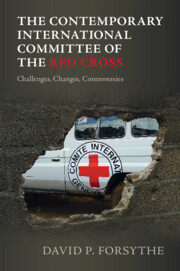Book contents
- The Contemporary International Committee of the Red Cross
- The Contemporary International Committee of the Red Cross
- Copyright page
- Dedication
- Contents
- Photographs
- Preface: Who and Why
- 1 The Contemporary ICRC and Its Critics
- 2 The ICRC and the Global Humanitarian System
- 3 History
- 4 History
- 5 The Red Cross Movement
- 6 The Red Cross Movement
- 7 ICRC Relations with Bern
- 8 ICRC Relations with Bern
- 9 Humanitarians and Business
- 10 Humanitarians and Business
- 11 Interpreting the Mandate
- 12 Interpreting the Mandate
- 13 Has the Traditional Focus Been Lost?
- 14 Has the Traditional Focus Been Lost?
- 15 ICRC Governance and Management
- 16 ICRC Governance and Management
- 17 Conclusion
- 18 Conclusion
- Epilogue
- Annex
- Index
15 - ICRC Governance and Management
Part I – The Top Level
Published online by Cambridge University Press: 01 February 2024
- The Contemporary International Committee of the Red Cross
- The Contemporary International Committee of the Red Cross
- Copyright page
- Dedication
- Contents
- Photographs
- Preface: Who and Why
- 1 The Contemporary ICRC and Its Critics
- 2 The ICRC and the Global Humanitarian System
- 3 History
- 4 History
- 5 The Red Cross Movement
- 6 The Red Cross Movement
- 7 ICRC Relations with Bern
- 8 ICRC Relations with Bern
- 9 Humanitarians and Business
- 10 Humanitarians and Business
- 11 Interpreting the Mandate
- 12 Interpreting the Mandate
- 13 Has the Traditional Focus Been Lost?
- 14 Has the Traditional Focus Been Lost?
- 15 ICRC Governance and Management
- 16 ICRC Governance and Management
- 17 Conclusion
- 18 Conclusion
- Epilogue
- Annex
- Index
Summary
This chapter covers much ground by looking into the black box of ICRC decision making. The subject is rarely covered by outsiders, given the difficulty of obtaining reliable information. Facts and interpretations are presented about the role and influence of the Assembly (governing board), Assembly Council, presidents, directors-general, and Directorate. There is a comparative evaluation of the roles and legacies of the three most recent presidents as well as the often ignored subject of the different directors-general (who are the CEOs of the organization or are supposed to be – if the presidents do not pre-empt that role). On the one hand, bringing in outside presidents from Bern with differing styles and values does make a difference both internally and externally for the ICRC. On the other hand, a Swiss cultural tradition of collective consultation and accommodation is at work, as presidents rarely take decisions entirely on their own. It is extremely rare to have public spats or resignations at the top of the ICRC over policy disagreements.
Keywords
- Type
- Chapter
- Information
- The Contemporary International Committee of the Red CrossChallenges, Changes, Controversies, pp. 311 - 340Publisher: Cambridge University PressPrint publication year: 2024

